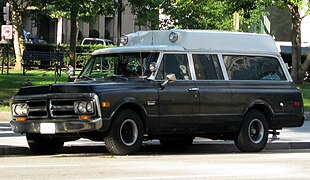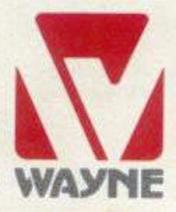
A school bus is any type of bus owned, leased, contracted to, or operated by a school or school district. It is regularly used to transport students to and from school or school-related activities, but not including a charter bus or transit bus. Various configurations of school buses are used worldwide; the most iconic examples are the yellow school buses of the United States which are also found in other parts of the world.
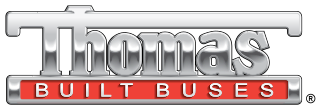
Thomas Built Buses, Inc. is an American bus manufacturer. Best known for its production of the first ever rear engine Type C school bus. Thomas produces other bus designs for a variety of usages. Currently, its production is concentrated on school buses and activity buses, along with their commercial derivatives.

Carpenter Body Works is a defunct American bus manufacturer. Founded in 1918 in Mitchell, Indiana, the company produced a variety of vehicles, with the majority of production consisting of yellow school buses for the United States and Canada.
Mid Bus was a corporation which specialized in manufacturing customized school buses. Formed in 1981 by former employees of Superior Coach Company in Lima, Ohio, it grew from a dozen employees working in a small facility in Lima to become one of the country's largest manufacturers of smaller school buses, moving to a much larger facility a few miles north of Lima in 1995.

A kid hack was a horse-drawn vehicle used for transporting children to school in the late 19th and early 20th centuries in the United States. The word "hack," meaning a horse-drawn cab, is short for hackney carriage. The vehicle was actually powered by both horses and mules and was usually loaded at the rear to avoid frightening the animals. In those days, most elementary school children in rural areas attended one-room schools. A typical kid hack would serve all the farms in the area of the school, and usually transport under 20 children.
Superior Coach was a coachbuilder in the American automotive industry. Founded in 1909 as the Garford Motor Truck Company, Superior is best known for constructing bodies for professional cars (hearses) and school buses. Following major downturns in both segments in the late 1970s, Superior was liquidated by its parent company in 1980. From 1925 to 1980, the company was based in Lima, Ohio.

The Crown Coach Corporation is a defunct American bus manufacturer. Founded in 1904, the company was best known for its Supercoach range of yellow school buses and motorcoaches; the former vehicles were marketed throughout the West Coast of the United States. Competing alongside Gillig Corporation and similar its Gillig Transit Coach, the two companies supplied California with school buses nearly exclusively into the 1980s. Crown also was the manufacturer of custom-built vehicles derived from its buses, including the Firecoach line of fire apparatus.
American Transportation Corporation was an American manufacturer of school bus bodies. Tracing its roots to Ward Body Works, AmTran was formed in 1980 following the 1979 bankruptcy of Ward to continue bus production. In 1991, the company became a subsidiary of Navistar International, leading to a series of acquisitions of school bus body manufacturers by chassis suppliers during the 1990s.

The Wayne Busette is a minibus that was assembled by Wayne Corporation. The Busette was first introduced as a compact school bus in 1974. The school bus body was designed to fit on a Chevrolet, Ford, or GMC chassis.

Cutaway van chassis are used by second stage manufacturers for a wide range of completed motor vehicles. Especially popular in the United States, they are usually based upon incomplete vans made by manufacturers such as Chrysler, Ford, and General Motors which are generally equipped with heavier duty components than most of their complete products. To these incomplete vehicles, a second stage manufacturer adds specific equipment and completes the vehicle. Common applications of this type of vehicle design and manufacturing includes small trucks, school buses, recreational vehicles, minibuses, and ambulances. The term "cutaway" can be somewhat of a misnomer in most of the vehicle's context since it refers to truck bodies for heavy-duty commercial-grade applications sharing a common truck chassis.

The Wayne Lifeguard is a type C school bus built by Wayne Corporation, introduced in 1973. Produced until Wayne Corporation declared bankruptcy and was liquidated in late 1992, the Lifeguard was also produced by successor Wayne Wheeled Vehicles until their closure in 1995. The Lifeguard introduced new methods of design and construction for school buses to improve their collision.

Divco was a brand name of delivery trucks built and marketed in the United States. Divco is an acronym which stands for Detroit Industrial Vehicles COmpany. Divco became known for its multi-stop delivery trucks, particularly in use as home delivery vehicles by dairy producers. From 1926 until 1986, Divco produced trucks of various sizes and job descriptions.

The Shyft Group, Inc., formerly known as Spartan Motors, is an American automobile design company that designs, engineers and manufactures specialty chassis, specialty vehicles, truck bodies and aftermarket parts for the recreational vehicle (RV), government services, and delivery and service markets. The company started in 1975 as a direct result of the bankruptcy of Diamond Reo. It is currently headquartered in Novi, Michigan and has 3,000 employees.

Crane Carrier Company (CCC) is a manufacturer that specializes in construction truck and garbage truck chassis. Located in New Philadelphia, Ohio, it was established by Robert Zeligson in 1946, along with the affiliated Zeligson Trucks. Since 2021, CCC has been owned by electric vehicle developer Battle Motors.
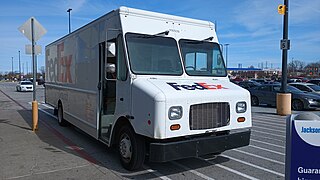
A multi-stop truck is a type of commercial vehicle designed to make multiple deliveries or stops, with easy access to the transported cargo held in the rear. They first appeared in the United States in the 1920s. They are usually vans or trucks designed to be used as fleet vehicles by businesses within local areas.
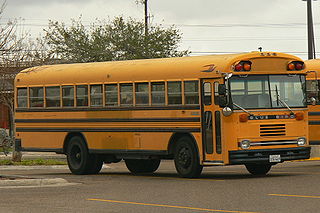
The Blue Bird TC/2000 is a product line of buses that was produced by the American manufacturer Blue Bird Corporation from 1987 to 2003. Introduced as a second transit-style product range alongside the Blue Bird All American, the TC/2000 was produced in front-engine and rear-engine layouts. While produced primarily as a yellow school bus, Blue Bird offered the TC/2000 in commercial configurations and numerous custom-built variants. For commercial use, Blue Bird badged the model line as the TC/2000 or the APC 2000.

The ThomasMinotour is a bus body manufactured by Thomas Built Buses since 1980. The smallest vehicle sold by the company, the Minotour is a bus body designed for cutaway van chassis. Primarily sold for school bus usage, the Minotour is also produced as a MFSAB or in specialized configurations specified by the customer.
The Wayne Lifestar is a product line of buses that was manufactured and marketed by Wayne Corporation and its successor company Wayne Wheeled Vehicles from 1986 to 1995. Produced nearly exclusively in a school bus configuration, the Wayne Lifestar used a transit-style body configuration with a front-engine chassis. Marking the return to transit-style production, the Lifestar adopted the single-piece body stampings of the Wayne Lifeguard in its construction.
Wayne Wheeled Vehicles (WWV) was a tradename of a division of a vehicle manufacturer that specialized primarily in the production of school buses. It was owned by Harsco Corporation, who purchased the rights to use the Wayne brand name, certain product rights, as well as parts and tooling during the liquidation of assets of the Wayne Corporation in late 1992.

REV Group, Inc. is an American manufacturer of ambulances, buses, commercial vehicle, firefighting vehicles, recreational vehicles and other specialty vehicles, as well as aftermarket parts and services. It provides vehicles and services for public fire departments and emergency services, as well as commercial infrastructure and leisure vehicles for consumers.












